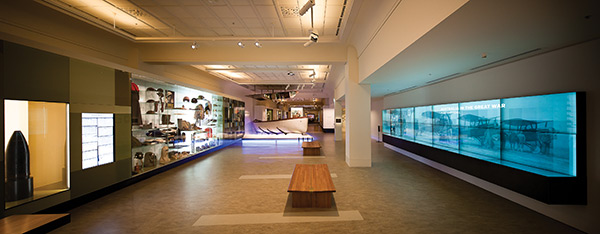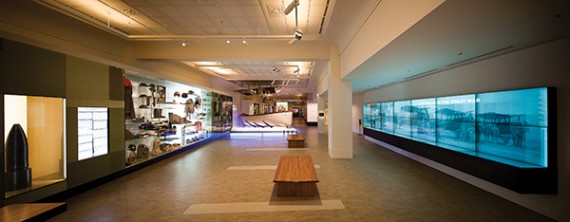
The new First World War exhibition at the Australian War Memorial is a moving and engaging showcase of the best in digital signage technology and media.
Story: Christopher Holder Image: Mental Media
This is a story about engagement. It’s a story about knowing your audience, and working hard to develop content that will capture the imagination of that audience. Not only that, but to serve that content in a way that your audience feels comfortable interacting with. Not only that but to house that content in technology that’s best suited to delivering it. In essence, this is a story about digital signage done right.
Of course, the true subject of the story is the new First World War exhibition at the Australian War Memorial in Canberra. But I wanted to make sure you don’t dismiss this article as just a ‘museum story’ where touchscreens are wheeled out to distract the rolling mauls of school groups for more than a minute. Rather, what we have here is a digital signage masterclass.
FRESH LOOK
The Australian War Memorial (AWM), to its credit, knew from early planning stages that this new exhibition would be different. Gone are the days of papier mâché models, static displays and a drafty theatrette. AWM engaged technical experts with specialist museum sector smarts as well as some newcomers who could bring a fresh perspective to how the content could be delivered.
And here’s the challenge: the AWM has no shortage of potential objects to display — thousands of items, artworks and photos are in the memorial’s archive. The digital ah-ha moment came when curators realised the AWM was no longer totally constrained by space on the wall or within glass cases. Many more related photos and objects could be available for viewing via digital displays.
And here’s where Sydney-based interactive media specialists, Holly, came to the party. Yes, there are thousands of items and photos that could be displayed, but which should be selected and why? The first question Holly asked: who exactly are the people viewing the exhibition?
“We knew there was a large, traditional group of people interested in the technology of war,” observed Holly Managing Director Zina Kaye. “These are the people you might assume would represent the largest group — men who want to know the calibre of that shell. But increasingly, there are people who go to hear the personal stories, and they crave layers of interpretive experience on a theme or some depth beyond the presentation of the piece.”
KNOW YOUR AUDIENCE
The AWM and Holly (independently of each other) commissioned research so as to better profile the patrons. And it informed the way in which the content is delivered. Zina Kaye: “We knew there wasn’t one single way of presenting the content. It needed to suit the various user profiles. For example, there’s the profile of an older lady who wants to know about the personal connections. And this has really informed how we presented the large ‘photo ribbons’ [a touchscreen wall populated with WW1 photos]. And it’s been enormously satisfying to see just how popular those displays are, with people looking at an image, checking the back of the photo, clicking on related images and getting immersed in the stories and connections. It’s real proof that the display is fit for purpose; it meets that group’s expectations.”
If the ladies are typically lapping up the photos and reading the diggers’ letters home, then hubby may well be at the artillery display, where the associated digital content is presented in a very different manner better suited to the more left-brain interrogation of a technology-focused bloke. Similarly, school children are often drawn to the dioramas where the digital content is presented very differently again — using clever depth of field techniques the school child can highlight aspects of the diorama.
NEW DEPTH
Another big ah-ha moment came when curators realised they were no longer constrained by traditional printed labels that accompanied a displayed object. Interested viewers could now drill down as deep as they like one ‘chunk’ of information at a time. Kate Morschel, Assistant Curator, Photography, puts it this way: “Static labels can only allow you to tell so much of a story. Digital labels allow you to add secondary content. We can link to other material that we otherwise couldn’t display in the galleries. Which gives us deeper insight into the personal experiences of the soldiers and their families.”
“Each digital sign has its own template in the CMS,” explains Holly Technical Director Mr Snow. “From there the curators can decide what related content might be displayed. So for a bayonet in a cabinet, the bayonet image on the digital sign may point to related objects just as the sheath with its own story or the soldier’s slouch hat etc.”
At the ‘Life at ANZAC’ display, the digital assets are tagged to ensure related material, such as the season, time of day, the food etc, allow larger groups of material to easily come to hand.” What’s more, the digital labels support up to five different languages across the galleries.
DIGITAL LABELS
The final ah-ha moment came when curators (particularly those in the photographic department) realised they could be far more responsive to the public’s photo caption corrections and amendments. The AWM receive these types of emails, phone calls and letters every day — correcting, clarifying or elucidating on the detail of the displayed portraits and photography — and the information can be updated in the database whereupon the digital signage is also immediately updated (the digital labels are networked to the server via ethernet) all without the issue of printing new labels etc.
Kate Morschel again: “We have a huge photographic collection. We get new identifications of portraits coming in every week and we can update captions immediately and remotely. We don’t need labels printed and checked. That’s going to a real advantage in the photo section and the AWM as a whole.”
THROWING AWAY THE COOKIE CUTTER
What’s obvious as you take a tour through the various uses of digital media is that no one technology, or packaging of the media, fits all. The packaging and presentation of the media is very dependent on the profile of the viewer, the desired dwell time (believe it or not, often the task it to reduce dwell time to ensure people keep moving) and the nature of the content. Meanwhile, the type and size of the technology is very dependent on the presentation. How big does the display need to be? What resolution? How many simultaneous touchpoints?
And the other key lesson to learn is in the CMS. The back-end interface has to be easy to manipulate, and the metrics need to be easy to interpret. Fine tuning a network is crucial. Holly freely admitted that it’s been spending time massaging the interface of a number of its displays. More ‘touch me here’ colour has been added to the graphics of the ‘ANZAC From Above’ video wall, for example.
I’m in awe of the quality of this exhibit and the consideration invested in its execution. I hope you find it as inspiring as I did.
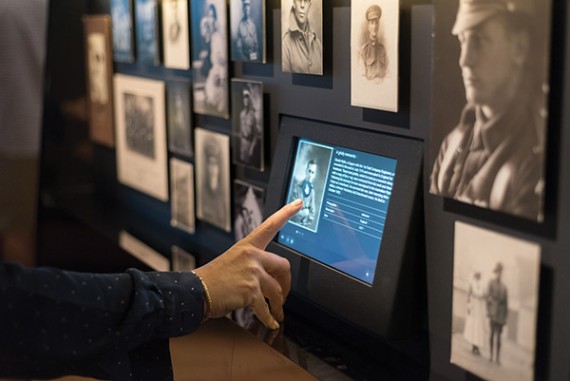
Image: Holly
USING ANDROID TABLETS
The world is awash with Android tablets.
To say ‘you can’t give them away’ has some truth… telcos pass them out like confetti as deal sweeteners. But at their core, the humble Android tablet is a super-cheap touchscreen digital sign.
The AWM’s digital labels are all Android tablets — normally two per showcase. The digital label is a godsend to curators (who can manage, edit, and update content easily and remotely) and to patrons (who can dig deeper into descriptions and explore related objects in a way conventional labels never could).
All the tablets are powered over ethernet and updated over ethernet via the CMS from a server. An ethernet to USB converter is used at the tablet to access push data and power to the device.
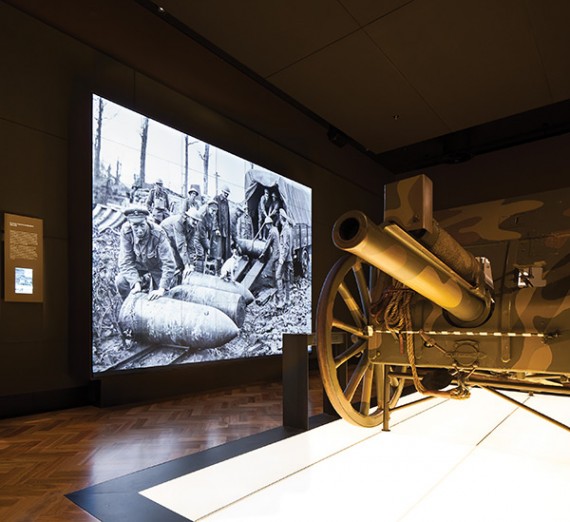
Image: Mental Media
CRAZY RESOLUTION
Two video walls display super-high resolution digitised WWI images. The official photography from the likes of Frank Hurley were originally on 8×10-inch glass plates. The resolution of these large-format photos is astonishing and needed an equally astonishing display technology to do the images justice.
Bruce Brown of Mental Media, the lead technical contractor, decided on a shootout of the rear-project video cube technologies. Eventually the Eyevis OmniShapes won the day in a hotly contested runoff with the Christie Microtile product. The Microtile is brighter but it was deemed the OmniShapes ran quieter and cooler, features particularly important to the AWM. The Eyevis OmniShape is a tad larger as well and can also be serviced from the front, which is important when rear access is limited. The 7×7 OmniShapes install displays the official photography at a mind-bending resolution. Every OmniShape is XGA resolution (1024 x 768) resulting in a total count of 10,000 pixels (at around 6m) across. The images — driven by 16 Synchronised Dataton Watchout Outputs from four Computers — dissolve from one to the next and it’s mesmerising. If you thought 4K resolution was an eye-opener then you simply won’t believe how beautifully these photographs are rendered.
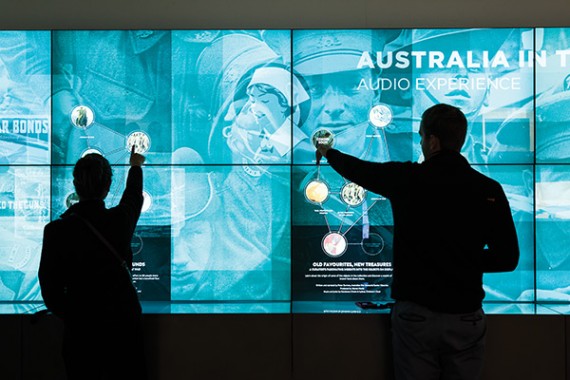
Images: Mental Media.
200 PHONES, 50+ WAPS & A BIG TOUCHSCREEN WALL
Mental Media has pushed the boat out here. This is an audio tour on steroids. I thought we’d investigate it not so much from an audio tour perspective but for the technologies it uses; technologies crucial to many a contemporary digital signage deployment.
The tour starts by grabbing your personal audio device (which just happens to be an Android phone with a heavily modified OS) and placing it on the large MultiTaction video wall in the orientation gallery.
There are five different audio tour programs to choose from. Once you place your device down on the touchscreen bench, and the MultiTaction cells recognises it, you’re presented with a menu. You can drag ’n’ drop the desired tour into a placeholder that then ‘loads’ (or, more correctly, selects) that tour onto the device. You’re now good to go. You don’t need to interact with the device again except to fine tune the volume. As you walk through the gallery, the device triggers content relevant to that position thanks to some clever indoor positioning. Here’s how:
There are some 56 wireless access points (WAPs) spread throughout the gallery; some directional, some omni. Mental Media measured the signal strength from those WAPs and created a fingerprint (or map) of the entire space. The app (developed by Art Processors) reads that fingerprint — effectively allowing the device to see all those access points. From there an API in the app (developed by the Fraunhofer Institute) interprets the signal strength, compares it against the known fingerprint, locates the device, and triggers the relevant audio track at the appropriate point. The WAP doesn’t carry or push data, it collects info from the devices.
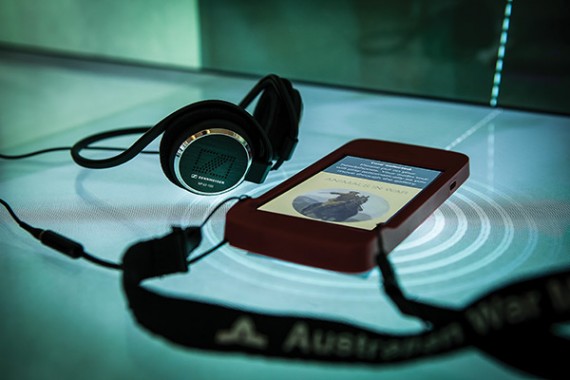
Does that sound a little like using beacons? Similar. Beacons use Bluetooth rather than wi-fi. Bruce Brown, boss of Mental Media, did a thorough appraisal of how the market is using beacons and/or WAPs and surmised that Bluetooth beacons weren’t going to cut it. He couldn’t find a beacon that wasn’t battery-operated, which makes them unsuitable for mission critical applications. Plus, when you have dozens of these points throughout a venue and a handful start to lose power, they’re effectively a lump of plastic stuck to a wall — potentially hard to locate when they’re not pinging you. Beacons also tend to be lower-powered than a WAP. Meanwhile, a WAP can be connected to power over ethernet — they can be powered and monitored remotely.
Bruce Brown: “WAPs are the way to go. We’ve used a standard Aruba WAP at the AWM. We then engaged the Fraunhofer Institute (the equivalent of the CSIRO in Germany, best known for developing the MP3 audio codec). It has a large department working on positioning in general. So we’re talking about driverless cars and sophisticated warehousing systems, or, my favourite, putting a device in a soccer ball to accurately sense its position on the field — which will change the way the game is described and analysed, and put an end to goal line disputes.
“We also engaged Art Processors, which did the positioning system for MONA in Hobart, to develop the app, building it around the Fraunhofer API that reads the wi-fi density ‘fingerprint’ of the gallery.”
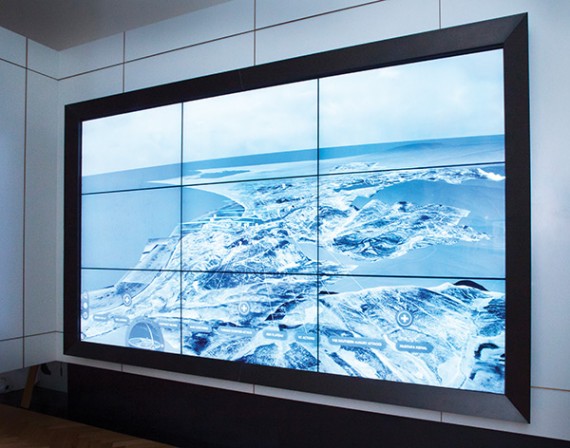
Image: Australian War Memorial
ANZAC FROM ABOVE
Remember the old-school 3D models, where you’d press a momentary switch on a panel and it would light up a bulb on the model? Aaron Pegram, Senior Historian, Military History, at the memorial does: “In the old galleries we had a large papier mâché model of the Gallipoli peninsula and of the fighting positions at ANZAC cove. Technology has advanced so much in the nearly 30 years since that was first put on display. Now we’re able to use up to 100 aerial photos taken of the Gallipoli peninsula by the members of the Royal Navy Air Service in the First World War. These were assembled into a large aerial mosaic then draped over a 3D terrain model of the peninsula. Using these technologies and the creative thinking of Holly, it’s forced us to look at that story in a new and exciting way. To make the story of the first world war relatable to all Australians.”
The realtime 3D environment on the 3×3 touchscreen (a Planar Clarity Matrix LCD Video Wall System) is something to behold, providing perspective and context to one of WWI’s most famous theatres of war, and allows those attending the museum a way of visualising the ‘where’ of the stories, letters and despatches.
The original reconnaissance photos were often shot on large-format film with spectacular resolution. The 100 or so images were stitched together in a montage. Holly then purchased modern-day satellite imagery of the area. The resolution of the data is a very workable 2sqm per pixel. The old aerial shots are overlaid on the new to present a 3D model that can be spun and manipulated on screen.
The 3×3 video wall exploits every pixel of the hi-def (1080p) displays for a total of 5760×3120 pixels. Each row of three screens is driven by a 4-channel AMD W7000 performance 3D video card. Each computer runs a copy of the custom 3D application designed and built by Holly, which syncs its state via the network, keeping all nine screens in step. When combined with the infra-red touch overlay, the result is a highly detailed image that responds instantaneously to touch.
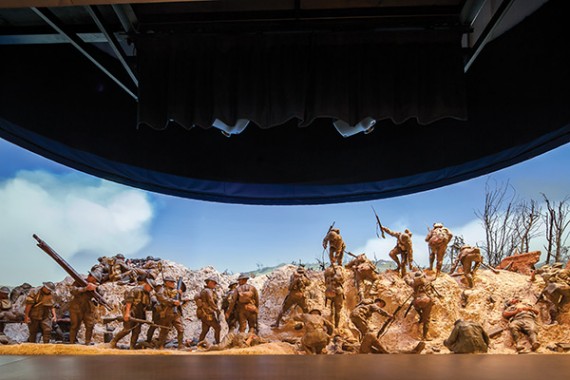
Image: Mental Media
Mt St Quentin: This traditional diorama has been updated with the addition of an animated backdrop. Projectiondesign F32 projectors take care of the eight hours of programming from the video artist. The installation was programmed and installed by Interactive Controls.
GALLERY HARDWARE HIGHLIGHTS
4 × Samsung 55-inch monitors
101 × Outform iMonitor 10-inch
14 × Outform iMonitor 18-inch
15 × Advantech 15-inch XGA Monitor
13 × Clarity Matrix 46-inch Video Wall Monitor (MX46HD ERO)
1 × Ideum 55-inch 4k Touchscreen
79 × Eyevis OmniShapes
44 × Lightware HDBaseT Transmitter/Receiver (DVI)
4 × Projectiondesign F32
18 x Medialon MIPHD interactive Players
2 × BrightSign Digital Signage Players
HONOUR ROLL
Cunningham Martyn Design (Exhibition design): www.cmdesign.com.au
Mental Media (Technical Direction/Content Production): www.mentalmedia.com.au
Holly (Co-Executive Producer AV Design & Production): www.hollysydney.com
Luscious International (Executive Producer AV Design & Production):
Sonar (Specialist Audio Services): www.sonarsound.com.au
Interactive Controls (Dataton Watchout & Medialon Show Control):
www.interactivecontrols.com.au
ITI Image Group (Eyevis): www.iti-imagegroup.com.au
Rutledge AV (Hardware Supply & Installation): www.rutledge.com.au
Arlo Mountford (Diorama Digital Backgrounds & Sound Design):
www.arlomountford.com

